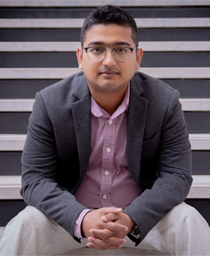Research
Contact
Communications Specialist
Faculty of Engineering
Spencer Engineering Building
Room 2072
Western University
Tel: 519-661-2111 ext. 87015
Email: engineeringcomms@uwo.ca
The Engineer's Impact - Arghya Paul
Your inside look at faculty’s research and its effect on society
In this new Q&A series, we’ll feature Western Engineering faculty members to gain a succinct overview of their research, understand its impact on society, and discover intriguing little-known facts.
Meet Western Engineering's Chemical and Biochemical Engineering Associate Professor and Canada Research Chair Tier 2, Arghya Paul, who has a joint appointment in the Faculty of Science in the Department of Chemistry.
Can you describe your research?
 My research focuses on the design and development of innovative clinically relevant healthcare materials with mechanical and biological functionalities for regenerative medicine and other biomedical applications. To do this, we use various lab-developed bioengineered nanomaterials, modified hydrogels, therapeutic cells, and biofabrication technologies. Examples of biomedical field-related work coming out from our lab include developing (a) stimuli-responsive hydrogels for drug delivery (b) soft, stretchy, tough hydrogels for tissue engineering (c) injectable hydrogels for 3D-bioprinting and stem cell delivery (d) nanocomposite coatings for surgical implants and other medical devices. Due to the interdisciplinary nature of our research, we always nurture a distinctive discipline-bridging research program that engages researchers from diverse backgrounds including engineering, biology and medicine.
My research focuses on the design and development of innovative clinically relevant healthcare materials with mechanical and biological functionalities for regenerative medicine and other biomedical applications. To do this, we use various lab-developed bioengineered nanomaterials, modified hydrogels, therapeutic cells, and biofabrication technologies. Examples of biomedical field-related work coming out from our lab include developing (a) stimuli-responsive hydrogels for drug delivery (b) soft, stretchy, tough hydrogels for tissue engineering (c) injectable hydrogels for 3D-bioprinting and stem cell delivery (d) nanocomposite coatings for surgical implants and other medical devices. Due to the interdisciplinary nature of our research, we always nurture a distinctive discipline-bridging research program that engages researchers from diverse backgrounds including engineering, biology and medicine.
Depending on the project, students working in my group get exposed to learning different hands-on tools and techniques – starting from synthesizing nanoparticles, 2D nanomaterials, polymers and hydrogels, in vitro characterization (mechanical, physico-chemical), testing the biological effects on human 2D and 3D cell culture systems (biological assays, molecular biology), optimizing drug release properties, and eventually testing on animals for evaluating in vivo safety and efficacy.
How does your research impact society in everyday life?
As the human population ages and the mortality rate decreases, incidences of impaired wound healing from tissue injury and pathophysiology will keep on growing, imposing a real threat to the overall healthcare system. My research aims to address these emerging clinical challenges by engineering new nano/biomaterials that can be continuously or intermittently exposed to body fluids without any detrimental effects. These new biomedical materials can be used to replace or restore tissue functions rapidly or to help in tissue-specific drug delivery. Dental and orthopedic implants, vascular grafts, heart valves and skin patches are some of the most well-known materials in everyday life. Some of the emerging biomedical engineering technologies entering the medical market include tissue-engineered constructs and organoids for advanced drug screening, nanoparticles for vaccines and drug delivery, tissue substitutes, and more.
What’s an interesting, little-known fact related to your research?
Although nano and biomaterials play an integral role in modern-day medicine, the first historical use of biomaterials dates back to ancient times, when ancient Egyptians used animal skin as sutures! Not just the Egyptians, the Mayan tribes have been known to successfully use blue shells as artificial tooth replacements between 350 and 400 CE. These “blue tooth” shells could integrate into the jaw when put into the jawbone. As time progressed, with more interdisciplinary knowledge and training in biomaterials science and nanotechnology, we have now begun to include drugs and cells in these biomaterials systems. This has led to the development of various new “spin-off” fields such as drug delivery systems, tissue engineering and biofabrications.

